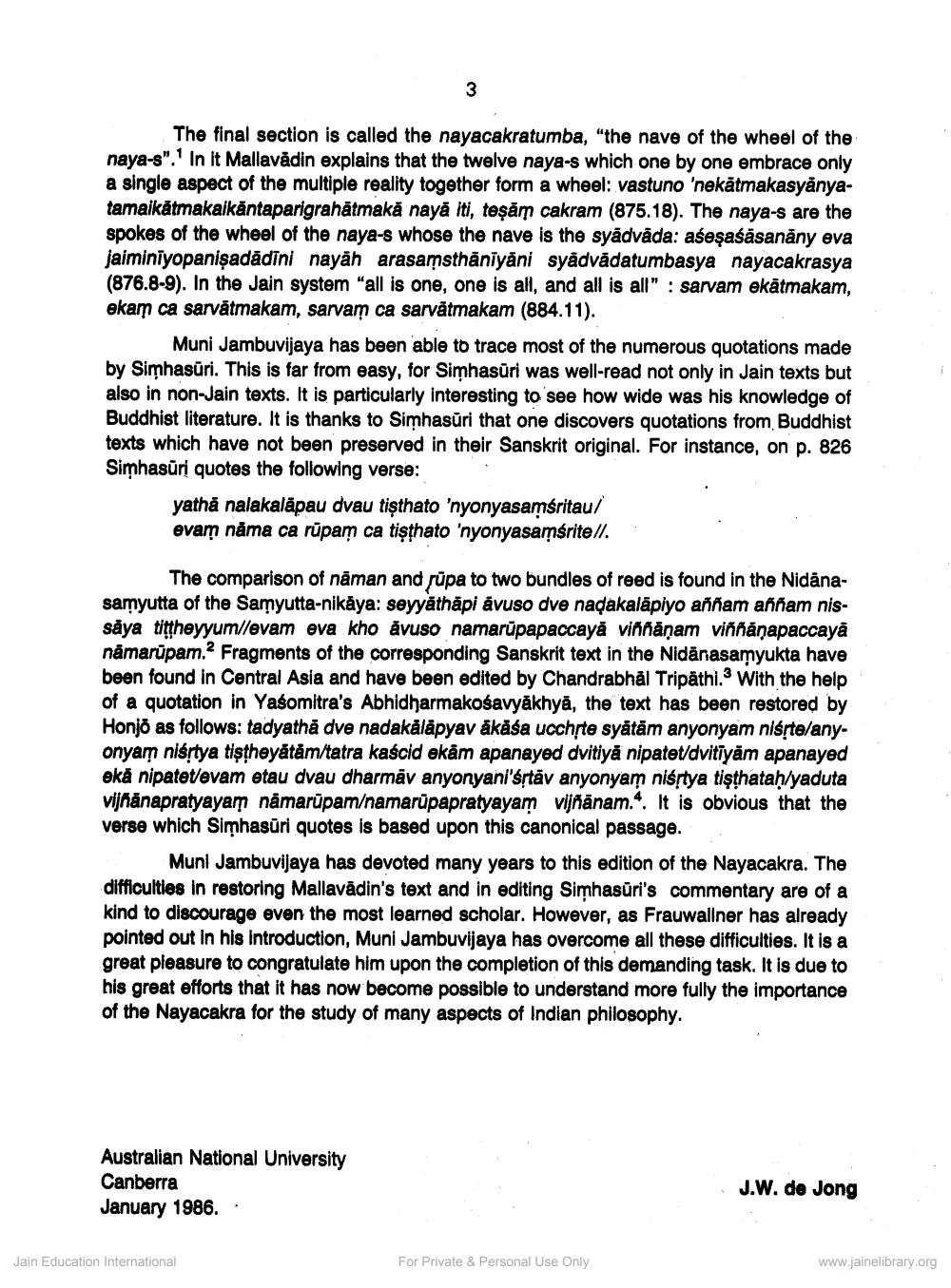________________
The final section is called the nayacakratumba, "the nave of the wheel of the naya-s". In it Mallavädin explains that the twelve naya-s which one by one embrace only a single aspect of the multiple reality together form a wheel: vastuno 'nekatmakasyanyatamalkatmakalkäntaparigrahātmakā naya iti, teşâm cakram (875.18). The naya-s are the spokes of the wheel of the naya-s whose the nave is the syädvāda: aśeşaśāsanāny eva jaiminiyopanisadādīni nayah arasamsthäniyäni syädvädatumbasya nayacakrasya (876.8-9). In the Jain system "all is one, one is all, and all is all" sarvam ekätmakam, ekam ca sarvätmakam, sarvam ca sarvätmakam (884.11).
3
Muni Jambuvijaya has been able to trace most of the numerous quotations made by Simhasüri. This is far from easy, for Simhasüri was well-read not only in Jain texts but also in non-Jain texts. It is particularly interesting to see how wide was his knowledge of Buddhist literature. It is thanks to Simhasüri that one discovers quotations from, Buddhist texts which have not been preserved in their Sanskrit original. For instance, on p. 826 Simhasüri quotes the following verse:
yatha nalakalapau dvau tişthato 'nyonyasamsritau/ evam nama ca rūpam ca tisthato 'nyonyasamśrite//.
The comparison of naman and rupa to two bundles of reed is found in the Nidanasamyutta of the Samyutta-nikäya: seyyāthāpi ávuso dve nadakaláрiyo aññam aññam nissaya tittheyyum//evam eva kho avuso namarüpapaccayā viññāņam viññāṇapaccaya nämarūpam.2 Fragments of the corresponding Sanskrit text in the Nidanasamyukta have been found in Central Asia and have been edited by Chandrabhal Tripathi. With the help of a quotation in Yasomitra's Abhidharmakośavyākhyā, the text has been restored by Honjo as follows: tadyatha dve nadakäläpyav ākāśa ucchṛte syātām anyonyam niste/anyonyam nisṛtya tiṣṭheyātām/tatra kasścid ekām apanayed dvitiya nipatet/dvitiyām apanayed ekä nipatet/evam etau dvau dharmav anyonyani'sṛtāv anyonyam nisrtya tişthataḥ/yaduta vijñānapratyayam namarüpam/namarüpapratyayam vijñānam.". It is obvious that the verse which Simhasüri quotes is based upon this canonical passage.
Muni Jambuvijaya has devoted many years to this edition of the Nayacakra. The difficulties in restoring Mallavädin's text and in editing Simhasür's commentary are of a kind to discourage even the most learned scholar. However, as Frauwallner has already pointed out in his introduction, Muni Jambuvijaya has overcome all these difficulties. It is a great pleasure to congratulate him upon the completion of this demanding task. It is due to his great efforts that it has now become possible to understand more fully the importance of the Nayacakra for the study of many aspects of Indian philosophy.
Australian National University
Canberra January 1986..
Jain Education International
For Private & Personal Use Only
J.W. de Jong
www.jainelibrary.org




